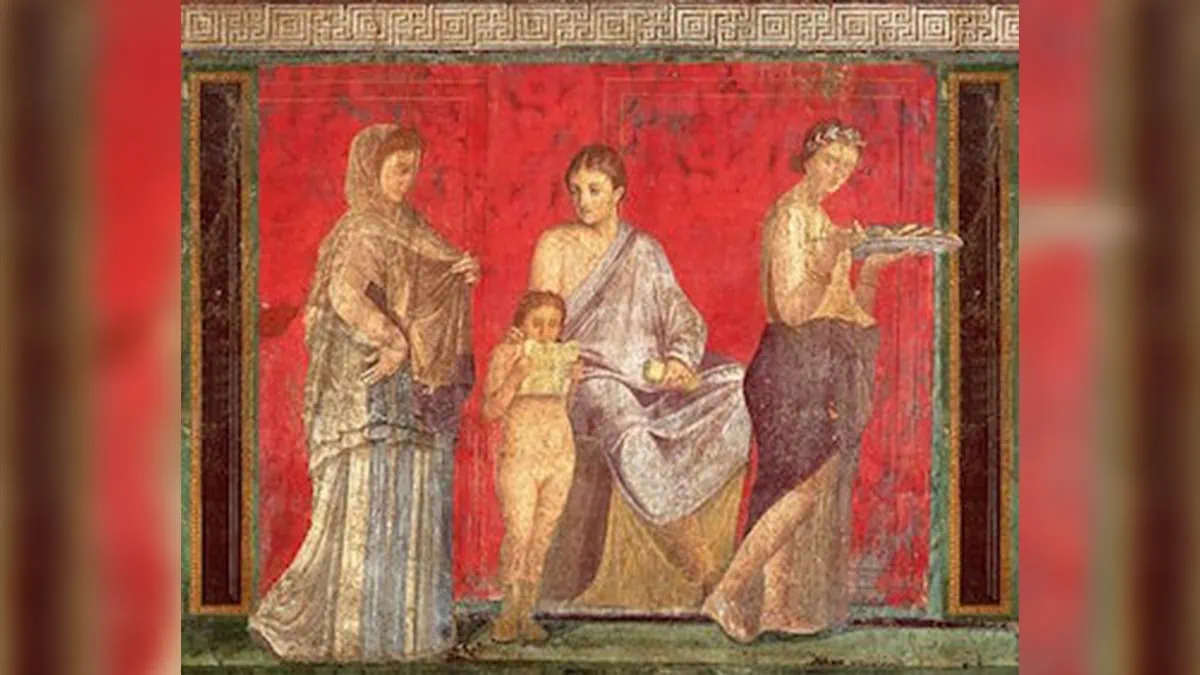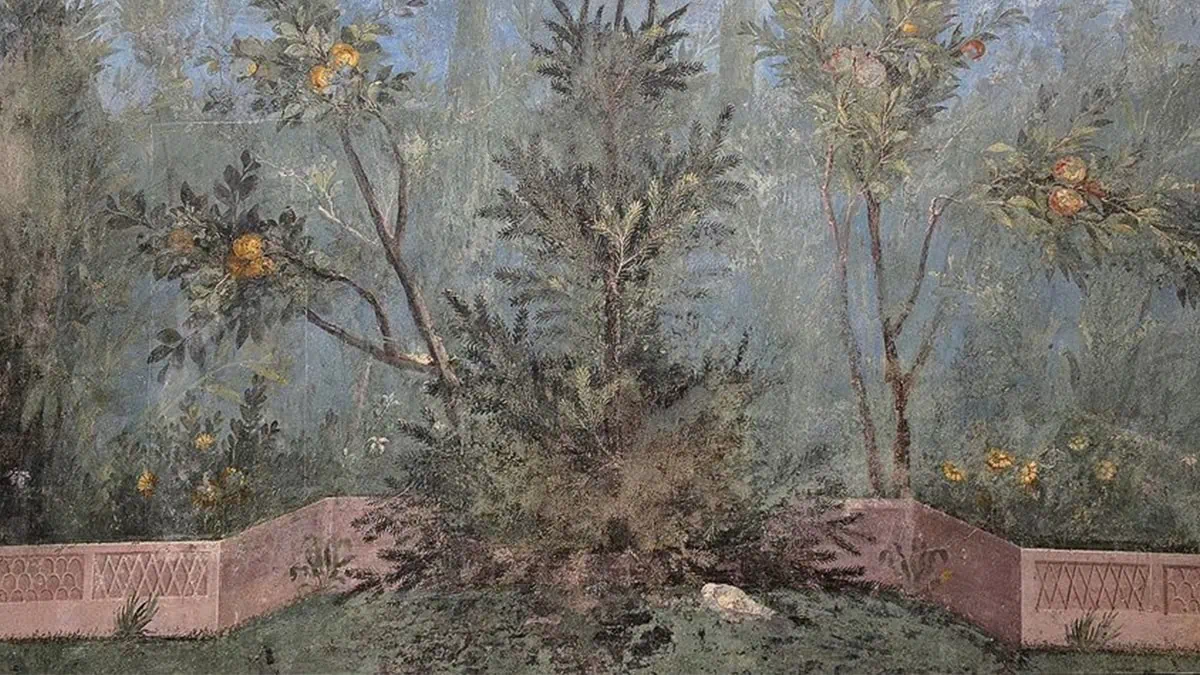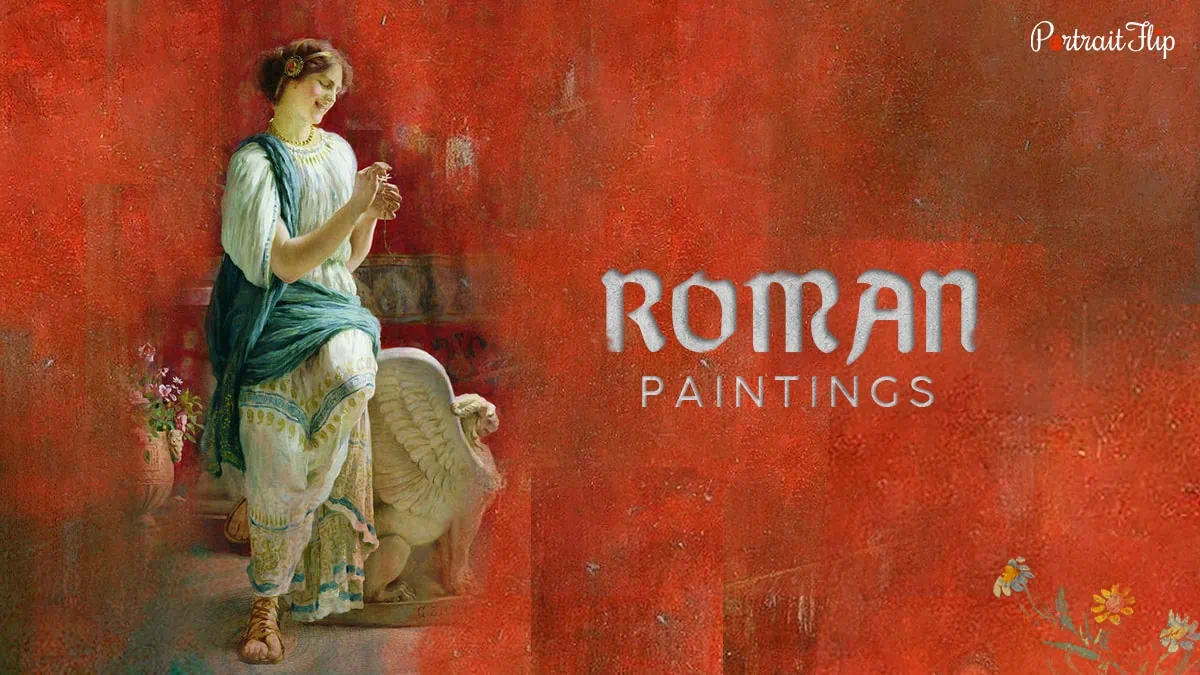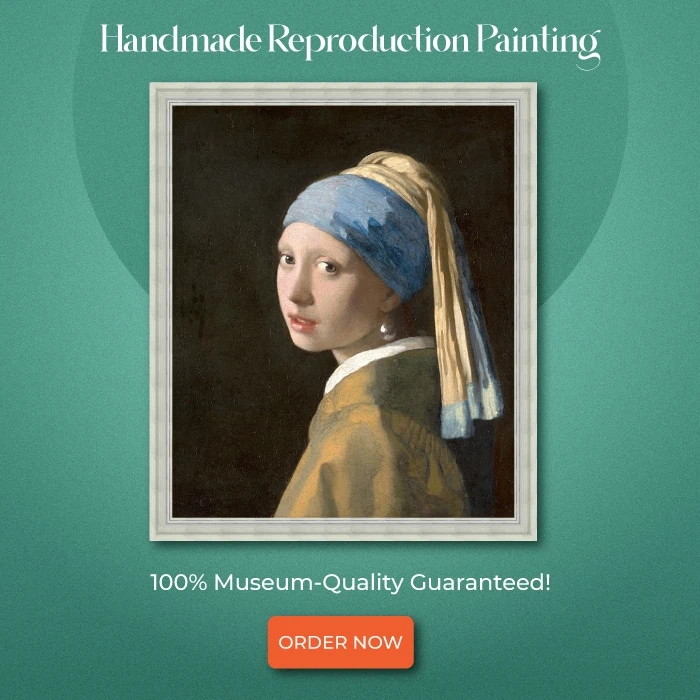When you think about Rome, what are some things that come to mind?
The tempting smell of pasta, cheese, gelato, or Colosseum?
Well, an art lover would definitely say the art of Rome.
Or, to be precise, the famous Roman paintings.
An influential mix of various cultures that has shaped a totally unique and fascinating style.
This style was adopted by the artists of Rome, which led to the creation of some of the famous Roman paintings.
Not only this, the styles and techniques were so intricate that even today, after ages, the paintings still hold the power to influence the art world.
The history of Rome has it that; despite being heavily inspired by Greek culture, Roman paintings still have a lot of unique features that make them stand out.
So, pack your bags and fasten your seatbelts, and let me take you on an exploration of ancient Roman art with some of the famous Roman paintings onboard.
Table of contents
A Brief Explanation of Roman Paintings

When you take a look at the Roman paintings, the first thing you notice is the varied themes and the exquisite depiction of subjects.
The subjects in the paintings might range from a basic animal sketch to a still life painting.
Also, the use of mural art can be prominently seen in some of the Roman wall frescos.
Many structural and landscape paintings can be seen in some of the Roman artworks.
Given the fact that ancient Roman art depicts elements that hint at the happenings of the Roman era, which were generally known to the community.
The Roman paintings were classified into four different types and styles, i.e., structural (or incrustation), architectural, ornamental, and intricate.
Therefore, Roman paintings have a variety of styles, from portraits to animals, still life, daily life, and mythological paintings.
Even at a point in some of the famous Roman paintings, the usage of erotic art can be seen as well.
Let us now learn how the Roman paintings were made and what exactly inspired the artists of Rome to create art in general.
What Influenced Roman Art?

Art in Rome has come a long way since Roman civilization began from the eighth century BC until the fifth century AD.
That is all that was inclusive in the era of ancient Rome.
The history of Roman art is interesting in general because a lot of people claimed that they copied the styles of Greek art.
It was claimed because the free-standing sculptures, mosaics, etc. that were made by the Roman artists were almost replicas of Greek art.
After a while, when the critics dug a bit deeper into the art culture, they realized that Roman culture was not only inspired by Greek culture but also Egyptian culture.
Given its close ties to ancient Greece across the Mediterranean, the history of Rome is frequently categorized as belonging to classical antiquity.
That is the ultimate reason why, for many years, Roman art was known as classical art.
It is a fact that during the ancient Roman period, paintings were the prime way of depicting ongoing stances and subjects.
That, in general, promoted the concept of Roman art and thus led to artists experimenting with their art styles and creating some famous Roman paintings.
Famous Roman Artworks
You wonder how the frescos and sculptures are still intact in Rome.
Well, the materials and the quality elements played a huge role in the creation of Roman artworks.
But when you take a look at the wall paintings and the paintings in general, they are not intact, and they are a bit washed off after ages.
Since the paintings were only meant to be temporary, many of the paintings that are safely restored and housed on the walls of Rome’s esteemed museums still exist.
So, let us take a look at some of the toughest and famous Roman paintings and artworks from the ancient Roman era.
1. The Dionysiac Frieze of Pompeii

| Medium | Fresco |
| Dated | C. 50 BC |
| Location | Villa dei Misteri, Pompei, Italy |
It is an exquisite Roman painting situated in the city of Pompei at the Villa of Mysteries.
This painting is a wall-to-ceiling painting that sports a bold red color that denotes violence and gruesome acts.
The fresco, which dates to about 50 BC, was painted directly onto the wall using pigment.
To your surprise, this famous Roman painting was discovered by the archeologists who were digging the site after the explosion of Mt. Vesuvius.
If you look at the painting, you can notice that the main subject of this painting is said to be the Greek god of wine, Dinosys.
And Frieze is an offering that is made to him; hence, this painting was titled The Dionysiac Frieze of Pompeii.
If you look through the breakdown of this painting, you can see that the artists have created the painting using light and dark pigments.
The woman is shown carrying a tray in the first frame of the fresco, starting a ritual or process.
Other scenes show an elderly Silenus and a reclining Dionysus.
This young lady is allegedly taking part in a ceremonial marriage to get ready for womanhood, according to a different reading of the fresco.
With different speculations surrounding the painting, this still remains one of the most visited sites in Pompeii where art lovers come to enjoy Roman paintings.
2. The Painted Garden Fresco at the Villa of Livia

| Medium | Fresco |
| Dated | 30-20 BCE |
| Location | Museo Nazionale Romano, Palazzo Massimo, Rome |
Take a look at this serene painting.
Isn’t it peaceful and serene, with an aura of calmness?
Well, this is one of the most famous Roman wall paintings from the history of Rome.
Can you believe this painting was part of an underground room?
The Villa of Livia was the name of the private residence that Caesar Augustus’s wife Livia Drusilla owned.
In the villa was an underground room that was constructed to fight off the heat during the summer.
To add depth and coolness to the room, this wall-to-ceiling fresco was created.
With its deeper hues and feel, this gives the space an even greater sense of depth and fully immerses the observer in a whimsical setting amidst the natural world.
To make the painting more realistic, the artist made sure to add in the elements like, umbrella pine, red fir, quince, myrtle, pomegranate, oleander, etc.
3. Polyphemus and Galatea in Landscape

| Medium | Early Imperial |
| Dated | The last decade of 1st century |
| Location | Metropolitan Museum of Art, New York City |
This Roman painting is an exciting composition from the last decade of first century.
Depicting the fresco in patterns of green and blue shades portrays the story of Andromeda and Perseus.
This wall painting was found in Agrippa Postumus’s Imperial villa at Boscotrecase.
Further examination of this painting reveals that Galatea, a sea nymph, is the woman he is in love with, on the left.
Another scene showing Polyphemus in a fit of rage and pain is painted on the right side of the picture.
This wall painting is now the most renowned Roman painting that is housed in the Metropolitan Museum of Art in New York City.
4. The God of Fertility: Priapus Fresco

| Medium | Fresco |
| Dated | First Century CE |
| Location | House of the Vetii, Pompeii, Italy |
One of the most famous Roman paintings that is also erotic art is The God of Fertility.
It is claimed to be Priapus, and this wall fresco is one of the most renowned in the lanes of Vetii, Pompeii.
In this painting, Priapus can be seen as a red man who is weighing his enlarged penis against a bag of fruit and money.
He is also claimed to be a god who protected people from evil energy and bad spirits, as well as the household from negative auras.
This painting was also used as a makeshift scarecrow for many years.
Whoever owned this painting knew this for the reason that the god directed money and fortune along with fertility.
Along with the other erotic art from the house of Vetti, this painting signifies the relationships with money, cupid and prosperity in Roman culture.
Suggested Read: La Primavera by Sandro Botticelli
5. The Catacomb of Via Latina: Daniel in the Lions’ Den

| Medium | Fresco |
| Dated | c. Mid-4th century |
| Location | Catacomb of Via Latina, Rome |
As a fact of surprise, Catacombs are known as one of the largest burial sites in ancient Rome.
But also, various scenes and instances have been mentioned in the Bible and have started immortalizing the characters from the Catacomb.
This Roman wall painting is a prime example of how the artwork was influenced by Greek art culture.
The catacomb denotes the biblical encounter between Daniel and the disciples in the lion’s den.
It is still decorated and is a great tourist attraction in Rome.
6. Cubiculum From the Villa of P. Fannius Synistor at Boscoreale

| Medium | Roman Fresco |
| Dated | ca. 50 – 40 B.C. |
| Location | The Metropolitan Museum of Art. |
This painting depicts a room that is covered in paint and other elements, covering a cave and a waterfall as well.
It is an art of Roman fresco that is now housed at the Metropolitan Museum of Art and decorates the walls of the highly prestigious museum.
When we learned about the painting in depth, we learned that before it’s burial in an explosion, this painting was commissioned for a bedroom.
And the huge painting was known for its highly ornate elements and intricate detailing.
Also, when you look forward in the painting, you can notice that each section of the painting depicts a different scene.
You can see an enclosed courtyard, flowers, vegetation and many other sections of the Roman Empire.
This painting also heads towards seaming the beautiful landscape scenes alternate between townscape paintings of ancient Rome.
Paintings That Revolves Around the Ancient Roman Mythology
Roman paintings have not only collected praise and compliments from people around the globe but have also influenced artists in the art world.
From modern to Renaissance artists, whoever was born in Italy has produced artwork, some of which would reflect the beauty of Rome.
Paintings by Caravaggio, Franciso Goya, and many other artists have significantly used the elements of Roman art.
So let us take a look at some of the paintings that were either inspired by the famous Roman paintings or hail from ancient Rome.
1. The Obelisk by Hubert Robert

| Medium | Oil on Canvas |
| Dated | 1783 |
| Location | Art Institute of Chicago |
The Obelisk is an oil on canvas that was painted in 1783 and was supposed to be presented at the salon at the Château de Méréville.
Artist Hubert Robert spent almost 11 years in Rome, studying and researching the art and architecture of Rome.
A perfect example was set between the imaginary and realistic scenery.
The perspective that was given to this work of art was that of inside a great hall of Rome.
The architectural interpretation of the Roman monuments and city is what makes it one of the most famous Roman paintings under the influence of Roman culture.
2. Amor Vincit Omnia (1601) by Caravaggio

| Medium | Oil on Canvas |
| Dated | 1601 |
| Location | Gemäldegalerie, Berlin, Germany |
One of the most renowned paintings by Caravaggio, Amor Vincit Omnia, is an oil on canvas painting that represents a nude angel sitting on the edge of a bed.
Caravaggio was always known for his classical representations of the biblical elements and the themes that were related to god and angels.
With that being said, even though Caravaggio was an Italian Baroque painter, he spent his final years working in Rome, Naples and Malta as well.
This artwork shows the winged Amor, also known as the Roman Cupid.
“Victorious Cupid” or “love conquers all” is what Amor Vincit Omnia means.
3. Saturn Devouring His Son (1819), by Francisco Goya

| Medium | Oil on Canvas |
| Dated | 1819 |
| Location | Museo del Prado in Madrid. |
One of the famous artworks from the era of Romanticism was painted by one of the most famous Spanish artists, Francisco Goya.
It is indeed one of the scariest paintings in the world.
Also, not to forget that this painting was created by Goya during the final years of his life and was labelled as the Old Master.
This painting claims that it is a Greek myth but was later Romanized.
In the specific region and era, the rumour said it that Saturn is afraid of the fact that one day he might be overthrown by one of his offspring.
To prevent that from happening, Saturn eats his sons as soon as they are born.
This painting is now housed at the Museo del Prado in Madrid.
4. Venus and Mars (1483) by Sandro Botticelli

| Medium | Tempera on Panel |
| Dated | 1483 |
| Location | National Gallery in London |
This painting that you can see above represents the famous couple of all time, Venus and Mars.
This painting was made to celebrate their wedding.
In the middle of the lush green forest that covers them, the young couple is seen unwinding.
Both of them are in a reclined position where Mars, the god of war, is practically nude and dozing.
Whereas the goddess of love, Venus, can be seen lying down and staring at Mars.
It is believed that they fell in love after their marriage, and that’s when Mars fell asleep and the couple were guarded by Satyrs.
This depicts the concept of Roman cupids, and the Satyrs are claimed to be the evils and the angels.
It is one of the famous paintings by Botticelli and is now housed in the National Gallery of London.
Wrapping Up
Phew! This was an artistic ride through the history of some of the most famous Roman paintings.
I hope that you enjoyed this journey through the ancient Roman artworks and got to learn some of the ways in which ancient Roman art became successful.
Even though it is claimed that Roman art was a copy of Greek art, upon further investigation, this claim was denied.
Kudos to the artists who created some of the most famous Roman paintings and helped in promoting the originality of Rome.
Talking about the originality of Rome, how about a souvenir?
I mean, even if you can’t go to Rome, you can get your favorite instance or painting from Rome hand-painted!
Yes, you can get a handmade portrait on your request, so to know more about it:
Author’s Note
Hey lovely readers,
I really appreciate your sincerity in learning about some of the famous Roman paintings.
If you find this blog helpful, then do leave your valuable feedback in the comments.
Also, we are active on all the leading social media platforms, so come say hi to us right there.
We also post fun content on YouTube, so don’t forget to subscribe to that as well.
See you soon, dear readers!
Stay hydrated and stay safe.
FAQs
The Roman paintings cover subjects like still life, self portraits, portraits of animals, murals, etc. Landscapes are also one of the most important aspects of Roman paintings.
There are a total of four types of Roman wall paintings, they are: structural (or incrustation), architectural, ornamental, and intricate.
Roman art started in 509 B.C.E.; it is also stated that the first style of Roman painting was the Incrustation style, which dates back to the 3rd century B.C.E. in Alexandria.
Roman art originated in Italy.






